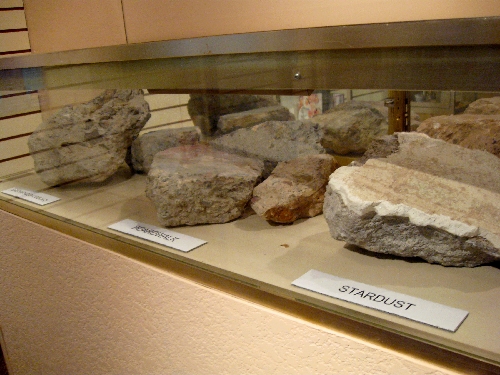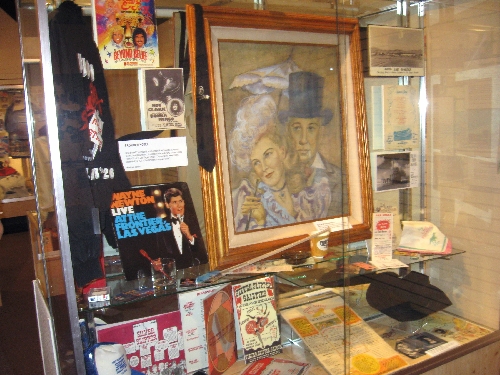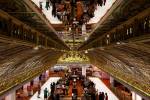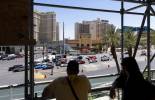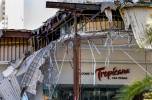Clark County Museum opens exhibit showcasing lost casinos
Because the Strip and downtown Las Vegas have changed throughout the years, the Clark County Museum is paying homage to the casinos that have been lost but not forgotten.
The museum opened its newest exhibit, "Lost Vegas: Bulldozed and Imploded Casinos of the Las Vegas Valley," May 25 in its Heritage Gallery, 1830 S. Boulder Highway.
The exhibit was originally scheduled to run until Aug. 26.
"But we are going to keep it until the end of the year," said Dawna Joliff, the exhibit curator. "People are going to be interested in seeing it."
Knowing they wanted to do something Las Vegas-themed for the next exhibit, Joliff said museum staff members weighed their options.
"We thought about doing it on entertainers," Joliff said. "People always ask about the places that were annihilated, not just change their names or got redecorated. The hotels that are gone."
The exhibit starts the same way the Strip did, with the El Rancho Vegas.
"It was the first to be built on the Strip," Joliff said. "It was also the first to go away."
The El Rancho Vegas opened in 1941 and burned down in 1960.
"The designs (of the hotels) were so different back then," Joliff said. "They had these long driveways and beautiful landscapes. It had a Western theme."
Former Strip hotels such as the Dunes, the Thunderbird, the New Frontier and the Aladdin also are highlighted. Pieces of rubble from some of the hotel implosions are encased and on display.
The setup goes from hotel to hotel, giving guests information on each casino.
"I put trivia tidbits throughout," Joliff said.
People can learn random facts such as the year that President Ronald Reagan, an actor before he took office, performed at the Frontier, or which hotel hosted Elvis and Priscilla Presley's wedding.
Joliff has received, and collected, casino memorabilia ranging from pool towels and restaurant plates to ashtrays and clothing.
"My brother's mother-in-law used to work at the El Rancho," Joliff said. "He had a towel (from the hotel) in the bathroom just hanging up. I said, 'That's an artifact,' and swiped it from him."
When museum administrator Mark Hall-Patton was on set for the History Channel's "Pawn Stars," where he serves as a historical consultant, he noticed that the store had a shoe phone with the Dunes logo on it.
"He told them they should donate that to us for the exhibit," Joliff said. "I got it two days before we opened."
The exhibit also has information about off-Strip hotels such as the Moulin Rouge, which opened and closed in 1955. The museum has several items from the Moulin Rouge from players club cards to an article in Jet magazine.
"It was ahead of its time," Joliff said. "It was the first interracial resort."
Joliff's favorite off-Strip casino was the Showboat.
"When it opened, it put 10 gallons of water from the Mississippi River into the pool," Joliff said. "I learned to swim there."
After it changed its name to the Castaways, Joliff said it didn't do as well.
At the end of the exhibit, some of the older and smaller casinos are mentioned, such as the first gaming establishment known as the Arizona Club located near First Street and Ogden Avenue in downtown Las Vegas that was built in 1905 and destroyed in 1946.
"It is just an empty lot now," Joliff said.
Other smaller casinos and hotels included The Meadows, which Joliff described as the first nice resort built in 1931 on Fremont Street and Charleston Boulevard, and the Klondike Hotel & Casino, which was across from the "Welcome to Las Vegas" sign.
"(The Klondike) is just concrete foundation now," Joliff said. "They had big plans (to rebuild it), but nothing ever happened."
As a lifelong resident of Las Vegas, Joliff said setting up the exhibit was a jog down memory lane.
"I would see a photo and remember something else about a hotel," Joliff said.
But that is also the same for guests who walk through the display.
"I had a guy in here the other day who said he remembered golfing at the Dunes," Joliff said.
Because of its historic value, Joliff said the museum would love to keep the exhibit.
"If only we had a place to put it," Joliff said.
Visitors can see the exhibit from 9 a.m. to 4 p.m. daily. Admission is $2 for adults and $1 for seniors and children.
For more information, call 455-7955.
Contact Henderson/Anthem View reporter Michael Lyle at mlyle@viewnews.com or 387-5201.



